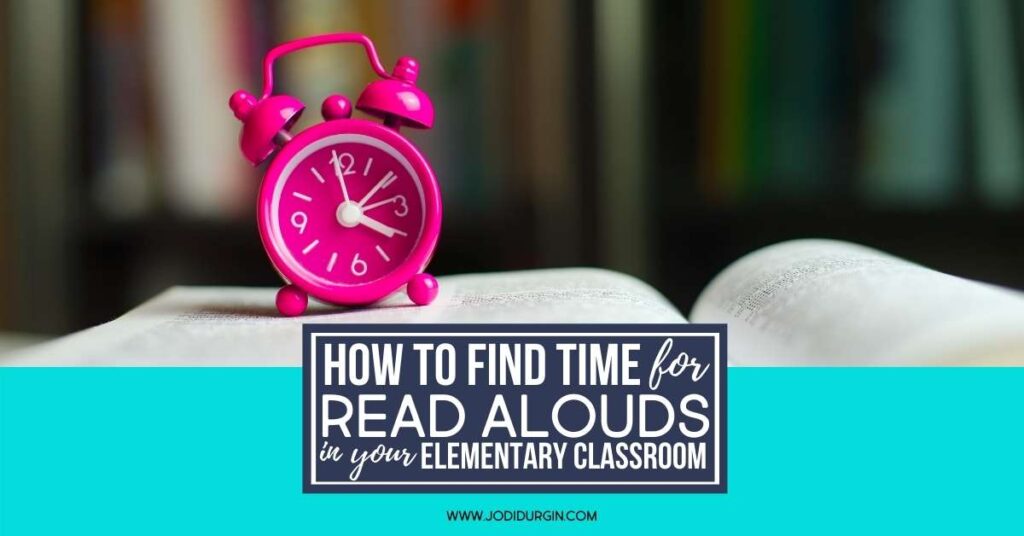Teachers know how valuable instructional time with our students is. Pull-outs for special education services, state testing, assemblies, and the days leading up to the holidays and vacations limit it. Additionally, we have mandates set by our districts and the federal, state, and local governments that limit the time we spend on things that we know to be important for our students. And don’t forget how there always seems to be one more thing that we need to implement during the school day with our students. All of these mandates can make it feel impossible to fit in things that we know our students need, but may not be a current priority within our school. An example of this is read alouds. We know the benefits of reading aloud to students to be limitless, but it’s hard to find the time for them. So, what can we do?
We have to get creative! Below are 5 tips for finding time for reading aloud to our students. In addition, this post includes a list of benefits of reading aloud to students that you can share both with your administrators and students’ families. Finally, this post lists suggestions on how families can fit time in to read aloud books to their children. You can share this list with them so they can support your efforts with your students. Read all about it below!

20 Benefits of Reading Aloud to Students
Reading aloud books to children is one of the most valuable experiences parents and teachers can provide to young learners. The benefits of reading aloud to students are really limitless! Here are some examples of how read alouds are so powerful:
- builds important foundational reading and writing skills
- models reading fluency and expression
- builds a love of reading and learning
- develops an interest in books
- demonstrates that written words carry meaning
- equips students with book handling skills
- exposes them to rich vocabulary above their independent reading ability
- makes challenging books accessible
- motivates them to practice reading independently to improve reading skills
- strengthens auditory processing skills
- increases reading comprehension skills
- models good thinking and problem solving strategies
- shows how to apply reading strategies to books
- improves self-regulation
- promotes critical thinking and higher level thinking skills
- creates a sense of community in the classroom
- provides opportunities to apply and build upon background knowledge
- exposes them to a variety of genres
- promotes curiosity and inquiry
- provides a framework to teach important skills, information, and lessons

5 Ways to Fit Read Alouds in Your Schedule
Now that we are reminded of the benefits of reading aloud to students, let’s find creative ways to fit read alouds into your busy school schedule.
1. Schedule it into Your Day
Set aside 15 minutes to read a book and discuss it with your students. If you are thinking, “Are you crazy lady? That’s impossible!” then try three times per week or perhaps once a week. Figure out what works best for you and your students. Perhaps it could be first thing in the morning, during your literacy block, snack time, right after lunch, or the end of the day.
2. Utilize Awkward Time Increments
If you finish up a lesson early and have 10-15 minutes available as a result, try using this time in a meaningful way by doing a read aloud with your students. Another example is that your students pack up quicker than normal and are waiting for the buses to be called. Use this time to share and discuss a text with them.
3. Integrate it into Other Content Areas
There are so many different ways to integrate children’s literature into other content areas: Writing, math, science, social studies, and STEAM. My favorite way to go about this is to introduce a lesson using a book. It’s a fun way to pull students in and get them excited about a topic!

4. Use it as a Support Tool for Tough Topics
There are so many challenges that come up throughout the school year: Being inclusive, managing frustration or worry, bullying, etc. When these challenges come up, pull out a read aloud that depicts the problem in the story so that it naturally springboards classroom discussions. Brainstorm possible solutions with your class and encourage thoughtful dialogue among students. If you have morning meeting, this could be a perfect time to have these discussions.
5. Make the Most of Days with Irregular Schedules
School days with field trips, assemblies, class parties, or field day can mess with your schedule. Take advantage of these days by making time for a read aloud. It is a great way to keep a calm classroom environment on what would otherwise be a crazy day!

5 Ways Parents Can Fit Read Alouds into Their Busy Schedules
Below are 5 suggestions you can share with your students’ families about how they can squeeze read alouds in their busy schedules. In addition to sharing these ideas, be sure to educate them on the benefits of reading aloud to students, so they understand what a great impact it can have on their children.
1. Schedule it into the Day
Encourage families to set aside time each day where they read aloud a book with their child. Perhaps it could be part of the bedtime routine. After their little one puts their pajamas on and brushes their teeth, they can share a story together. If nights are too crazy, then maybe they could consider making it part of the morning routine.
2. Play Audio Books in the Car and Discuss the Story
Suggest to families that they purchase audio books for when they are in the car. Pause the audiobook to stop and talk about what is happening in the story. This is perfect for families that are always on the go!
3. Employ the Help of Older Children
Recommend that families invite their older children to read to their younger children. It gives the younger sibling the opportunity to listen and think about a story and motivates them to learn how to read like his or her older sibling, the older sibling time to practice reading and build confidence in his or her reading abilities, and it becomes a bonding experience for the two. Everyone wins!
4. Make the Most of Waiting Times
Offer the idea of families keeping a bag of books in the car so that when they are waiting for an eye appointment, haircut, or sibling’s basketball practice, they can make the most of this time.
5. Share Reading at the Dinner Table
Propose that families read aloud a short story, news article, or magazine article at the dinner table and discuss it as a family. This promotes good family discussions, exposure to different types of texts, and shows kids that reading is a priority in the family.

Get the Free Reading Resource Bundle
In this free reading resource bundle, you will receive:
- a list of seasonal picture books for each month of the year
- blank book lists for you to record your own titles
- printable reading logs for your students
- print and go monthly reading challenge charts

In closing, we hope you found this post about the benefits of reading aloud to students and how to make time for it helpful! If you did, then you may also be interested in my Clutter-Free Classroom Teachers Pay Teachers store as well as these posts:


